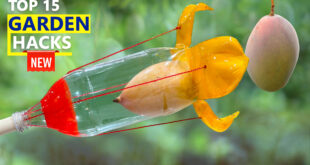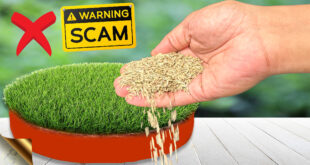Today on my viewers request, I have prepared this interesting episode on the 10 golden rules and Tips and hacks for successful Cloning of plant stem cuttings in Water. You will learn the Nitrogen Draining Concept and the Oxygenation Concept for successful rooting, plus you will also learn what nutrients to feed or how to fertilize your fresh stem cuttings.
This method of cloning plant cuttings in water is an age-old practice.
If you want to increase the success rate of growing plants in water or rooting your cuttings in water, you need to follow certain simple tips. The most important advantage of this, whether cuttings are grown in soil or water or even air layering, you get an identical copy of your Parent plant (also called the Stock Plant). But This is not the case with seed grown plant, which differs significantly from its Parent plant.
Please Watch all these Steps and Tips till the end to achieve a great result and have fun with your gardening hobby. Also some scientific concepts specially Tip #4 and Tip #8 like the nitrogen draining concept and the oxygenation concept may be completely new and really interesting to most of us. Also Some of these tips are common when you are propagating cuttings in soil. With these simple tips and scientific concepts, you can achieve a success rate of nearly 100 percent.
- 1. Taking Healthy Cuttings:Yes this is the first and foremost job which is most important to achieve a good successs rate. Take a cutting from a healthy mother plant, which is free of pest and disease and has good active growing branches. Choose Semi-woody cuttings, not hard woody or too soft ones which can easily rot.Making a Sharp Cut at 45 degree angle. A sharp cut with a sharp cutting tool or blade is also an important factor for success. Preferably sterilize the cutter with some disinfectant like hydrogen peroxide or any household antiseptic like Dettol.
Cut about half an inch below a node – this is the area where rooting starts and which is to be inserted into water or your rooting solution.3. Length of Cuttings: This is generally 6 to 10 inches or atleast 2 or 3 nodes above the rooting node. The length depends on the internode distance of a branch. Remember one rule of thumb: , the success rate of cloning is inversely proportional to the internode distance. That means the lesser the internode distance, the greater the chances of success.
4. Drain Out Nitrogen for the Branch: As you all know, nitrogen slows down rooting process. Pouring lot of water on the plant or the branch which is to be cut, is believed to drain out nitrogen. Do this and then take your cuttings from the plant. I don’t know how this happens. but if u know about the concept please let us know in the comments box below this video.
5. Do Not Fertilize your Parent Plant: Applying the same concept of nitrogen drain out, better not to feed the plant atleast 15 days prior to taking cuttings.
6. Prepare Rooting Solution: You can use just plain clean soft water. Better avoid salty water or chlorinated water to increase the chances of success. The second option is to add some ingredients into this water which serves two functions. First, prevents contamination and rot and secondly, it helps accelerate the actual rooting process. You have many options for this:
a. Rooting Hormone Powder with indole butyric acid or NAA (naphthalene acetic acid) – just add half a teaspoon of this to your glass or the container holding the cutting and mix it well. Add this everytime you change the water till the rooting starts.
b. Aspirin or willow water: Aspirin which is chemically Acetyl Salicylic Acid serves both functions, including rooting. You can watch a detailed video on this from a link at top right corner of this video.
c. Fresh aloe vera gel extracted from aloe leaf also contains salicylic acid and other ingredients which help in preventing rot and accelerate rooting.
7. Use Clean Containers and Change Water or your Rooting Solution every 2 to 3 days: Take clean containers preferably transparent ones, so that you can actually see through for the root development.
- Oxygenate the tissues: Yes this is another important tip for succuessful rooting. Lift the cutting out of the water once daily and stir the water atleast once to oxygenate it. Scientists have proved that plants need dissolved oxygen to survive and that the cutting will consume all the dissolved oxygen in the immediate vicinity of its rooting zone, so water needs to be stirred in order to maintain healthy root formation. This is infact the basics of Aeroponics and Hydroponics which will try to discuss in detail in some other episode.9. Submerge the cutting into water or your rooting solution, atleast 2 inches above the lowermost node, that is the rooting area. Keep it Undisturbed preferably on a window sill to receive indirect light and also optionally Suspend the Cutting into the Container through a plug like a piece of foam or a cloth. Also it’s a good idea to cover it with a polythene bag intermittently, specially in night time if its too cool. This is to provide the optimum temperature and humidity levels for rooting.
Now the Question is: what do I feed them: giving nutrients would be pointless until roots develop as the cuttings cannot absorb any mineral content. Once the rooting starts, you can feed with very dilute solutions of water soluble NPK or even very dilute compost tea. But one hack to counter the stress or the shock to these little cuttings. Vitamin B1 that is Thiamine in the rooting solution is thought to help alleviate any stress, like how we use Epsom salt solution to water the plants to counter transplant shock. This effect of vitamin B-1 is actually derived from researches based on tissue culture media. But I am not sure of this and the mechanism of action and the molecular concepts behind this.
10. Transplant into Soil: Once you see multiple roots atleast 4 to 5 roots of atleast about an inch in length, you can carefully transplant into your potting mix.
 GKVKs – Gardening Tips and Store Gardening Tips and Store
GKVKs – Gardening Tips and Store Gardening Tips and Store




Good knowledge